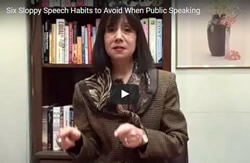Diane DiResta, CSP, was interviewed by Yitzchok Saftlas, host of Mind Your Business on 77WABC radio, during the C-Suite conference at the NY Times building, in New York City. DiResta stated that, “Speaking is a leadership skill and is the new competitive advantage. You can no longer be without this skill.”
15 Tips to Master Video Presentations
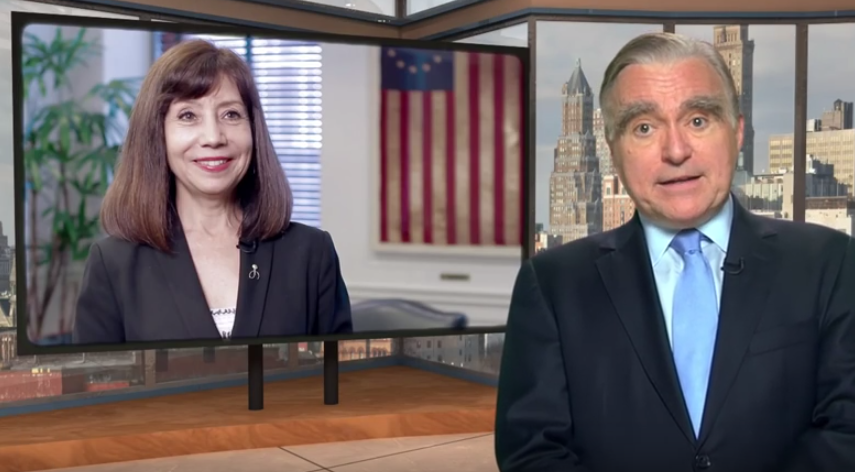 What do today's business presenters have in common with television anchors? They both have broadcasting skills. With youtube being the number two search engine and companies demanding online learning, public speaking has gone digital. According to Business Insider 2014, “About 50 million people in the U.S. now watch video on their mobile phone." Public speakers who shun the camera will be left behind.
The first step to being a master presenter is to understand the difference between in- person speaking versus video presentations. Here are a few tips for speaking in a digital media world:
What do today's business presenters have in common with television anchors? They both have broadcasting skills. With youtube being the number two search engine and companies demanding online learning, public speaking has gone digital. According to Business Insider 2014, “About 50 million people in the U.S. now watch video on their mobile phone." Public speakers who shun the camera will be left behind.
The first step to being a master presenter is to understand the difference between in- person speaking versus video presentations. Here are a few tips for speaking in a digital media world:
- A video recorded presentation is one way communication. That means you can’t read the audience and pivot in the moment to meet their needs. So it takes a lot of preparation to deliver a compelling message and provide value to your target audience.
- In the case of teleconferencing, appoint a facilitator at each site to manage the technology and to facilitate the meeting. Be aware of delay time and plan for it by practicing longer pauses. Pause and silently count to four. That will allow enough time for the speaker to finish and for the listeners to hear the last word.
- Know the time zone of your audience. It may be 8:00 a.m. in New York, but if it’s 2:00 p.m. in Amsterdam you don’t want to start the meeting with “Good morning”.
- Display a visual agenda. People need a roadmap and it will keep the meeting or presentation focused.
- Have a back-up plan. Be able to continue by telephone if the video fails. It’s a good idea to do a test drive of the technology 15 minutes before the presentation. As a hedge, send the PowerPoint deck in advance.
- Make love to the lens. People don’t know where to look when speaking on skype. When you look directly at the caller, they see you looking down and you lose that eye connection. Try this instead: When speaking to them, look directly at the webcam. When you are listening, look at the caller.It’s uncomfortable speaking to a camera; yet that’s exactly what the presenter needs to do during webcasts and media interviews. In live presentations the presenter feeds off the audience reaction. With video, the presenter imagines the lens is a person. It’s important to maintain a steady gaze. If your eyes are darting you’ll be perceived as nervous or untrustworthy. And practice smiling and talking. Broadcasters do this easily. A serious delivery will weaken the likability factor.
- Video is an energy drain. There is an exchange of energy between a speaker and an audience. When that energy is strong, it’s palpable. That’s not the case with video. As a result, you won’t convey energy the way you do in a live performance. For that reason, you need to pump up your performance on video. In a video the presenter can easily come across as flat. Push your energy higher than normal to have the same intensity level when you’re live and in person.
- Minimize gestures. Wide, sweeping hand movements are distracting on video. Use fewer and smaller gestures. If seated, sit with both feet on the floor and lean forward at a 15 degree angle. Place both hands on the table. This is a confident speaking and listening position. You’ll be perceived as confident and it will stabilize you. Avoid excessive head nodding and jerky movements.
- You are always on stage. If someone else is speaking, chances are you are still in view. Be careful about sloppy behaviors such as slouching, looking at your phone, side talking or looking bored. The presentation isn’t over until the camera is off.
- You’ll look heavier on video. Video is two dimensional which flattens the presenter. I once was videotaping a client for a presentation. It was amazing that when I looked at her directly she appeared slim. When I looked through the camera lens she looked heavier.To manage the widening effect, dress for the camera.Remember that light colors enhance and dark colors diminish. A client of mine was unhappy with her video because she thought she looked heavy. She was wearing a boxy white jacket which gave her a wide appearance. We did a make-over. This time she wore a tapered navy blue jacket which had a slimming effect.Another way to look thinner on video is to stand at a ¾ angle with your hips back. If you’re in a close-up, drop your forehead slightly to avoid a double chin.
- Wear the right colors. White and black are not good colors for video. White creates glare. It’s better to wear off-white or pearl grey. Icy pastel colors look washed out on camera and are not a good choice. Red can bleed or look muddy. A better choice is burgundy. Avoid stripes and large bold patterns. You’ll look like a TV test pattern. When in doubt, blue is a good choice for video. It films well and psychologically blue means trustworthy, conservative, stable.
- Lighting is key. While lighting is important in a live performance, harsh lighting won’t be as damaging. On video, fluorescent lightening will highlight lines and shadows in the face and can also hurt the eyes. Use soft lighting that flatters your face.
- Choose the backdrop carefully. When doing a video presentation always ask about the backdrop. If you’re filming from home, make sure you don’t have messy papers stacked up behind you. If you’re filming off-site, choose clothing that will work with the backdrop. Early in my career I was being filmed for a speaker showcase. I asked the producer if my fuchsia suit would televise well. He said yes. Unfortunately. I asked the wrong question. I should have asked “What color is the backdrop?” When I arrived I found myself in front of an orange curtain. The fuchsia suit bled into the orange and looked terrible on film. This wouldn’t have been an issue in a live presentation.
- You cannot be boring. Engagement is crucial.You have 5-10 seconds to grab attention in a video presentation. The key to success in video presentations is good storytelling and a highly targeted audience who will appreciate the value. Being boring is deadly in any venue. A live audience will show more tolerance by listening longer. If your video presentation is boring the viewer will click off instantly. A video presentation needs to have greater engagement. A measure of engagement, is how many people watch the entire video. According to Industry standards, a 15-20% complete viewing of a 2 minute video is considered a good engagement rate. That means most viewers are not watching the complete video.
- The day of the talking head is over.To increase engagement, keep a fast pace. You need to keep the video moving. Add slides and images while you are speaking. Fly in bullet points as you speak. Keep the presentation brief. If it’s a formal speech aim for no more than 18-20 minutes. Sales presentations need to be crisp, engaging, fast moving, and brief.In my own experiment, I noticed that every time I reached for the fast forward knob, the picture would change. This happened continually as if the videographer was reading my mind. Intrigued, I started to look at the time. The frames were changing every four seconds-the same time I wanted to fast forward.
If you’re not producing video presentations you’re leaving money on the table. Your digital footprint is now an important part of your personal brand. Interviewers are asking for videos. LinkedIn now allows videos to be added to profiles. Video is the ultimate selling tool. It addresses the know, like, trust factor.
Video is not going away. To be current, you need to master video presentations.
Another Screw Up By Debate Moderators
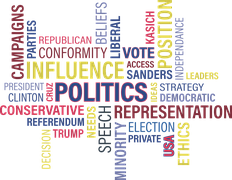 It was round two for Hillary Clinton and Donald Trump at the second presidential debate held at Washington University in St. Louis.
The atmosphere was tense as evidenced by the candidates' refusal to shake hands. But while the focus is supposed to be on the candidates, they were upstaged by Martha Raddatz, who co-moderated with Anderson Cooper. Where are the good moderators? It's been a challenge to respect the facilitators in these debates because they don't seem to understand the role of a moderator. Here are some guidelines for being an effective moderator:
It was round two for Hillary Clinton and Donald Trump at the second presidential debate held at Washington University in St. Louis.
The atmosphere was tense as evidenced by the candidates' refusal to shake hands. But while the focus is supposed to be on the candidates, they were upstaged by Martha Raddatz, who co-moderated with Anderson Cooper. Where are the good moderators? It's been a challenge to respect the facilitators in these debates because they don't seem to understand the role of a moderator. Here are some guidelines for being an effective moderator:
Ask prepared questions. The quality of the questions will impact the quality of the debate. Both Anderson and Martha asked relevant questions and invited guests to participate.
Share the spotlight. During the debate, Anderson ceded control to Martha who dominated the conversation. At times, Anderson seemed invisible. What is the point of having two moderators unless they are both contributing?
Keep control. The job of the moderator is to begin and end on time and to give equal time to both candidates. There were several times when they allowed the candidates to speak longer than the allotted two minutes. It's also the job of the moderator to keep the focus and redirect the candidate to answer the question.
Be impartial.The kinds of questions and the number of questions should not favor one candidate over another. This wasn't always the case. Trump alluded to "three on one." Skilled moderators do not show their hand. The audience should not be able to sense the preference of the moderator.
Facilitate don't participate. This is where Raddatz really blew it. A moderator asks questions but doesn't offer opinions. The purpose of the debate is to showcase the candidates- not the moderators. Facilitation skills seem to be difficult for many professionals to master. In order to be a good facilitator you need to suspend your ego and draw the conversation from the participants. A facilitator is the conductor, not the musician. Facilitation is different from interviewing and from reporting. Maybe it's time for journalists to be trained in facilitation skills.
End on a positive note. People remember the last thing they hear so you don't want to wrap up in a negative atmosphere. The moderators did a good job by allowing the last question of the evening to be "What do you admire in the other candidate?"
Who would you choose to moderate the next debate?
What Hillary Clinton Can Teach Us About Using Your Voice
 There’s been talk about Hillary Clinton’s coughing and whether she’s damaging her voice. It made me think of how speakers unknowingly abuse their voices.
Often public speakers yell in order to project. Yelling is not only irritating to listen to, but will cause eventual hoarseness. It causes strain on the vocal folds. Presenters should request a microphone, project from the diaphragm, and not from the neck muscles. And incessant coughing can also cause damage. Coughing causes the vocal folds to forcefully slam together.
There’s been talk about Hillary Clinton’s coughing and whether she’s damaging her voice. It made me think of how speakers unknowingly abuse their voices.
Often public speakers yell in order to project. Yelling is not only irritating to listen to, but will cause eventual hoarseness. It causes strain on the vocal folds. Presenters should request a microphone, project from the diaphragm, and not from the neck muscles. And incessant coughing can also cause damage. Coughing causes the vocal folds to forcefully slam together.
One of the bigger problems for professional and public speakers is laryngopharyngeal reflux, an inflammation near the back part of the larynx due to acid rising to that point. Thirty-five million people in the United States have acid reflux.
“This inflammatory condition causes the vocal folds to function less efficiently leading to vocal fatigue and poor projection,” states Dr. Thomas Murry, clinical director, professor of speech pathology in otolaryngology at the Voice and Swallowing Center of Columbia Presbyterian Medical Center, Columbia University. Reflux is most common among speakers because so many speakers are on the go, stressed and may have poor diets. Being aware of the symptoms of reflux can help speakers take preventative steps to take care of the problem.
The big five symptoms are:
- Vocal fatigue
- Lack of projection
- Hoarseness as the day wears on
- Throat clearing
- Increased phlegm in the throat
Preserving the Voice
To preserve the voice, don’t constantly clear your throat or talk over noise. Instead, Murry recommends the silent cough technique.
The silent cough technique is a way to clear the throat without violently banging the vocal folds together. The silent cough is done by breathing in air and blowing the air out fast through your throat and mouth without making a sound. Immediately after the silent cough, you should tuck your chin down toward your chest and make a strong swallow. The silent cough often clears mucous that clings to the vocal folds or near them. The silent cough is an important element of vocal hygiene and helps to prevent unnecessary trauma to the vocal folds. It is especially important to use the silent cough after surgery to the vocal folds.
If the symptoms of reflux continue, go to the doctor before the problem becomes severe.
Another common physical voice problem is vocal paresis, a weakness in one or both vocal muscles manifesting in breathiness or fatigue. Both folds must come together symmetrically to produce a clear, resonant voice. Vocal paresis can be caused by a flu or viral infection. When the nerve is inflamed, the condition can last for six months to a year, causing the speaker to change habits to adjust to the inflammation. A monotone may be an indicator of a minor defect or partial paralysis. Also, public speakers who have difficulty projecting could have some vocal fold asymmetry. Tape yourself and listen to how you sound. Also, be aware if you find people asking you to talk louder. This may be an indication that you are suffering from vocal paresis.
Breathiness and Hoarseness
Women are more inclined to get polyps or nodules, which are growths that prevent complete closure of the vocal folds and create breathiness. “In females, the back part of the vocal folds never completely closes due to the way they are formed. So the female voice is always going to be a little bit more breathy than the male’s because of anatomy,” states Murry.
If you are suffering from breathiness, take action and get checked out. It is always better to be safe than sorry. The definition of the term “frustrated and feeling sorry for yourself" is to wake up to find that you’re hoarse when you have a big speaking engagement.
When hoarseness is the problem, first determine that there is no hemorrhage. Then start a process of hydration and steam. Public speakers should travel with a facial steamer. When staying in a dry hotel room, opera singers use them every hour for five minutes. Alternatively, you can make boiling water in your coffee pot, pour it into the ice bucket, and throw a towel over your head to reap the benefits of steam.
To avoid becoming hoarse, avoid alcohol, chocolate and caffeine before a speech. They will dehydrate the mucous membranes, causing hoarseness. Finally, after an all-day motivational program, get plenty of rest and drink lots of water. Before you climb into bed, toss out those mint chocolates on your pillow; they are a double whammy because the mint relaxes the lower esophagus and allows acid to come up.
Making a difference in the lives of your audience is done with your instrument—your voice. With proper breathing, voice training and vocal hygiene, your voice will be strong, healthy and you’ll master true vocal power.
How to Give a Eulogy When You're Not a Public Speaker
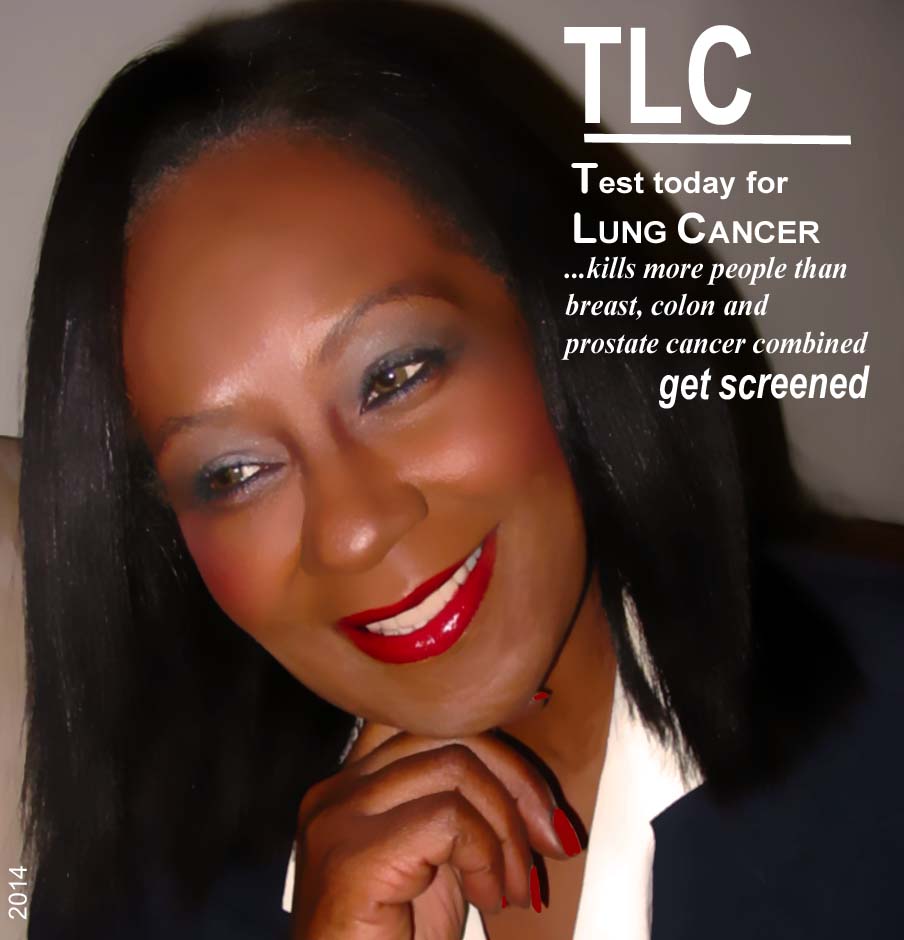 What do you do when a loved one dies and you're the person to give the eulogy? Last weekend I attended the memorial service of my friend, Linda who lost her battle to lung cancer at the age of 63.
Memorial services are usually bittersweet. The service was beautifully inspiring and sad at the same time. The tributes from her sorority sisters gave an insight into her personality and the reader of her legacy left a powerful impression of Linda's contribution of the world. The soloist sang Linda's favorite song with feeling and his voice filled up the room with love.
What do you do when a loved one dies and you're the person to give the eulogy? Last weekend I attended the memorial service of my friend, Linda who lost her battle to lung cancer at the age of 63.
Memorial services are usually bittersweet. The service was beautifully inspiring and sad at the same time. The tributes from her sorority sisters gave an insight into her personality and the reader of her legacy left a powerful impression of Linda's contribution of the world. The soloist sang Linda's favorite song with feeling and his voice filled up the room with love.
The preacher read a passage from the Bible and eloquently spoke about Job, He told us that we had not lost anything. That Linda had been given to us as a gift and we shared that gift for 63 years. His sermon and his delivery were inspiring, uplifting, and impassioned.
While the preacher was a trained public speaker, the day may come when you are tapped to give the eulogy. You don't have to be experienced in public speaking to be effective. Here are six tips to remember when memorializing a loved one's life:
Develop a Time Line. If you don;t know where to begin, draw a horizontal line on your paper and mark down significant events or memories. It can be in 5 or 10 year intervals or any time frame that works.
Discover a Theme. Once you look at the timeline, you may see trends or stories that can be folded into a them. Ex. You always did it your way. You always went the extra mile.
Sequence your Ideas.Next, organize the most important and meaningful events and stories in a sequence that flows and is easy to follow. Don't give a biography of the person's entire life. Keep it brief.
Keep it Positive. Don't dwell on the failings or negative times unless it culminates in a story of the hero's journey. Interjecting humor can help lighten the atmosphere.Talk about the deceased in a positive light but do be genuine. What contributions did the departed make? How did the loved one make people feel? How would that person want to be remembered?
Speak from the Heart. It's fine to use a script or notes, however; tell stories. Don't sound like you're reading a text. If you knew the person, share your experience. Relive the moments and events and give people a sense of the person. And it's okay to cry. Have people nearby and take a minute to compose yourself and continue. The audience will understand.
Bury your Fear. Put your focus on telling the person's story and not on your nervousness.Jerry Seinfeld said it best when he quipped, "Most people would rather be in the casket than giving the eulogy." Remember it's not about you.It's about them.
What a Cashier Taught Me about Presentations
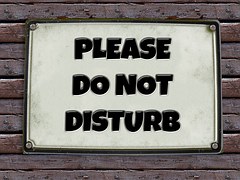 I went to the supermarket to pick up a few items. Not wanting to wait in line, I found a cashier who was without customers. She had her back turned as she was shuffling a deck of coupons. I approached her and stood there expecting her to stop what she was doing to serve me. She did not. She continued to organize the coupons and never said a word to me or attempted to make eye contact. She placed a rubber band around the coupons, put them in the drawer and without saying a word, started to ring up the two items.
I went to the supermarket to pick up a few items. Not wanting to wait in line, I found a cashier who was without customers. She had her back turned as she was shuffling a deck of coupons. I approached her and stood there expecting her to stop what she was doing to serve me. She did not. She continued to organize the coupons and never said a word to me or attempted to make eye contact. She placed a rubber band around the coupons, put them in the drawer and without saying a word, started to ring up the two items.
It was like I wasn't there.
Viewing this as an experiment in communication, I said nothing. Neither did she. After ringing up the groceries she spoke for the first time. "$6.07, " she said. As I was digging for change she turned and talked to the other cashiers. I paid the bill and left. Talk about feeling invisible.
Yes, she was a young person being paid minimum wage but that's not an excuse for being rude. (Although I doubt that was her perception). I've had friendlier and more helpful service from others in her position. It made me think about what was being communicated by this cashier. By not acknowledging that I was standing in front of her I felt ignored and not valued as a customer. She had no idea of the impact of her silence and lack of friendliness. By not greeting a customer and avoiding eye contact, she tarnished the brand of the store. There was little difference between doing business with her and scanning my own groceries in the self service line. I left with a negative feeling about the supermarket although I've shopped there many times.
My husband reminded me that he doesn't like going to our local Thai restaurant even though the food is good and inexpensive. He dislikes the waitress who doesn't smile and looks annoyed all the time. He calls her "a pill". Think about it. He doesn't want to eat where the food is good because he doesn't like her attitude. She non-verbally communicates that the customers are an annoyance to her. She's creating a negative feeling.
How often do we minimize soft skills in the business world? Something as seemingly basic as greeting a person or making eye contact can have a big impact. It's part of your presentation. In graduate school, I waited tables at a New York City fast food restaurant in the middle of Times Square. (That's another story). I quickly learned the ROI of interpersonal skills. A greeting, friendly tone, and a smile could yield a better tip.
There's a barista at my local Starbucks named Gus. He remembers everyone's name. When I walk in the store, he starts making my green tea because he knows my order. Gus makes customers feel special and I always ask for him.
So the point is this. We are always presenting ourselves and the organization we represent. McDonald's understands this. Every entry level worker greets each customer by looking at them and saying "Welcome to McDonalds". They are well trained because the company recognizes that communication impacts their brand. It's the intangibles that drive the tangible. The next time you have a meeting or presentation, be fully present, acknowledge the other person and whatever your topic, serve it up with a smile.
Public Speaking is Going to the Dogs
 It's the Dog Days of August and public speaking is going to the dogs - in a good way. Animals, especially dogs, have been used in pet therapy programs for years. Research shows that pets can help lower blood pressure, and reduce anxiety. Bonnie Auslander, who specializes in business communication, decided to use dogs to help reduce public speaking anxiety in front of an audience.
Knowing that dogs are successfully used in pet therapy, Auslander applied the idea to speaking anxiety. The sessions were part of a pilot program at American University. They recruited 12 canines who were chosen for their calm personalities. Nervous business students were paired with a friendly dog.
It's the Dog Days of August and public speaking is going to the dogs - in a good way. Animals, especially dogs, have been used in pet therapy programs for years. Research shows that pets can help lower blood pressure, and reduce anxiety. Bonnie Auslander, who specializes in business communication, decided to use dogs to help reduce public speaking anxiety in front of an audience.
Knowing that dogs are successfully used in pet therapy, Auslander applied the idea to speaking anxiety. The sessions were part of a pilot program at American University. They recruited 12 canines who were chosen for their calm personalities. Nervous business students were paired with a friendly dog.
Did it work? The evidence was anecdotal. The students reported that looking at dogs made them smile.
True confession: When I was starting out as a public speaker, I would place stuffed animals in chairs and would practice my speech as well as my eye contact. The only downside was when my husband walked into the room and saw me talking to a bunch of chairs.
The idea was to mentally remove the negative image of a scary audience and to replace it with something or someone who is accepting.
While we don't know if this experiment in reducing speech anxiety will transfer to a human audience, it can't hurt. The dogs allow the public speakers to "feel the love", and it's a win win. The public speaker reduces anxiety and the canines get undivided attention.
So I guess it's true. Every dog has it's day.
How To Be More Media Savvy
Today’s presenters need to have broadcasting skills. I’ve been saying that for years. Even if you don’t do media interviews, you may give a presentation through videoconferencing, livestream, elearning, skype, or a webcast. There’s no avoiding it. You need to know how to present yourself on camera. Even job candidates are being interviewed through video. And if you’re speaking at a conference, you may be filmed or asked to give some comments on video.
When your 15 minutes of fame arrives will you be ready?
To learn how to shine in media, watch my interview with Employment Law Today. You’ll gain practical tips you can apply to your next video appearance.
You’ll learn:
- The biggest mistake in a media intervew
- How to handle difficult questions
- The difference between speaking to a live audience and speaking on television.
The Fear Worse Than Public Speaking
 Public speaking is not the top fear. Don't get me wrong. I work with clients all the time to build their confidence so that they can express their ideas. Speaking enables leaders to influence, build relationships, and advance their careers. It's one of the most powerful business and personal skills with far reaching impact.
But public speaking fear is a temporary obstruction. It can be overcome. However, there is another fear that is much greater. It's slowly creeping into our culture.
Public speaking is not the top fear. Don't get me wrong. I work with clients all the time to build their confidence so that they can express their ideas. Speaking enables leaders to influence, build relationships, and advance their careers. It's one of the most powerful business and personal skills with far reaching impact.
But public speaking fear is a temporary obstruction. It can be overcome. However, there is another fear that is much greater. It's slowly creeping into our culture.
It's the loss of freedom of speech.
Today, as we celebrate Independence Day, I heard a disturbing report on a television news segment. The University of North Carolina published a guidebook for employees on how to avoid micro aggression. They listed words that should not be used in conversation. Here are a few:
Don't say:
- Christmas Vacation because it could insult someone who practices a different religion
- Wife/Girlfriend or Husband/Boyfriend because it discriminates against other sexual preferences. (So do I deny I'm married ?)
- Round of Golf because some people can't afford to play (Have they not heard of municipal courses?)
- I Love Your Shoes because that's discriminating against women. (I have never met a woman who was insulted when I complimented her shoes).
ARE THEY KIDDING? What kind of craziness is this? Who could take this seriously? What great material for Saturday Night Live.
I certainly don't mean to single out UNC. There are other universities that actually have designated free speech zones. REALLY? The first amendment of the Bill of Rights grants freedom of speech not in geographic zones but everywhere. The purpose was to limit the power of government and now we have universities telling us what we can say.
The comedian, Jerry Seinfeld stopped performing at colleges because he got tired of political correctness. Where is our sense of humor?
Whoever controls language controls thought. And that's scarier than any fear of speaking in public. This July 4th, let's give thanks for freedom of speech and have the confidence to speak out.
Happy July 4th !


Public Speaking in Soundbites
Are you able to get to the point? Do you know how to speak in soundbites? Speaking in soundbites help your message land. I created a video book of public speaking soundbites from a recent presentation:
How many times have you heard a presentation only to have your eyes glaze over? The speaker takes too long to get to the point and your brain simply shuts off. Overtalking is deadly when trying to get approval for an idea or when selling your product or service.
And it happens in networking meetings.People deliver a verbal resume instead of an elevator pitch. By the time it's the last person's turn it's time to go home. What many people don't understand about public speaking and clarity is that less is more. Some public speakers give so much detail that the listeners need a machete to cut through all the verbal weeds. To avoid going down a rabbit hole and losing your audience forever, try speaking in soundbites instead.
A soundbite is a short sentence or phrase that is easy to remember. I media train clients who have television interviews to speak in soundbites.The goal of a media interview is to provide "quotable quotes" that contain your message points. Soundbites make the message memorable.
Contrast these two messages:
"You need to learn to be a better speaker because you'll have to go on interviews and sell your ideas and there is a lot of competition and it will be harder to get the job or get promoted if other people speak better and you don't sound confident or clear, or concise so you should practice or take classes so you're not left behind."
"Speaking is the new competitive advantage"
Which do you remember? Which can you repeat?
So when it comes to communication and making the message land, Less is More.
What's your favorite sound bite? Comment below.
Speaking Lessons from Shark Tank
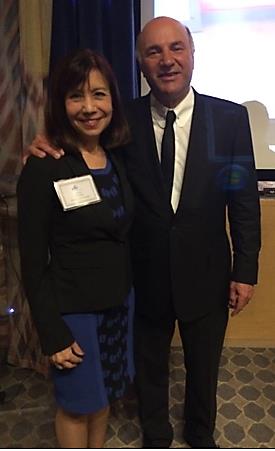 Last month I had the good fortune to hear Kevin O’Leary of Shark Tank speak at a networking event. Unlike typical celebrity events, this venue was intimate, allowing contact with Mr O’Leary and even a photo opp.
After drinks and hors d’oeuvres, we gathered into a small theater-like room to hear him speak. His speaking approach surprised me and I found it refreshing. Instead of the usual PowerPoint, or main stage podium presentation, Mr O’Leary entered the room in an unassuming manner yet strongly communicated executive presence. After being introduced, he stood next to a leather chair, his only prop a wine glass in hand as he told his story.
Last month I had the good fortune to hear Kevin O’Leary of Shark Tank speak at a networking event. Unlike typical celebrity events, this venue was intimate, allowing contact with Mr O’Leary and even a photo opp.
After drinks and hors d’oeuvres, we gathered into a small theater-like room to hear him speak. His speaking approach surprised me and I found it refreshing. Instead of the usual PowerPoint, or main stage podium presentation, Mr O’Leary entered the room in an unassuming manner yet strongly communicated executive presence. After being introduced, he stood next to a leather chair, his only prop a wine glass in hand as he told his story.
He began by telling us about his mother’s influence on how he thinks about his investments today and took us on a journey from his early, hungry years, the “tough love” lessons from his mother, and how he is raising his children based on his own upbringing. He discussed the issue of how to stay grounded after acquiring riches, his decisions and relationships on Shark Tank, his current enterprises, and advice for today’s entrepreneurs. His decisions to do business with partners isn’t contingent on liking them and he was clear about separating personal feelings from business.
Politics was not part of the presentation until the last questioner asked for his opinion on the Presidential election which he answered directly. Ever the salesman, he ended with a call to action. He let the audience know that he owned a vineyard and we could buy his $60 red wine for $10 on QVC.
Mr. O’Leary didn’t miss a beat. He spoke fluently, conversationally, and matter-of-factly, as he wove sage advice through his stories. This was not a speech but a conversation. And the audience loved it! It was interesting how much of the presentation I retained because he made the message memorable.
What I learned was this: The best public speakers stay true to themselves. Kevin O’Leary has a quiet style but was no less captivating than a Tony Robbins. He told his personal story and made a connection with the audience. By sharing business successes and an inside view of SharkTank, he provided real value to an audience of entrepreneurs. He didn’t waffle when asked a political question. He put a stake in the ground. And of course, he told us how to get a discount on his wine. The audience was captivated. And that’s why he’s called Mr.Wonderful.
Six Sloppy Speech Habits
You may look like a million but if you want to close a big sale, gain approval from a co-op, or interview for a board position, looks aren’t everything. How you sound is equally as important. But many presenters let careless speech habits sink their chances of making a positive impression and reaching their goals. Here are six common speaking mistakes and how to keep them from sabotaging your presentation success. Watch the video and read Diane’s tips below.
https://youtu.be/1geJXMFCfF8
1. Non-words:
Filler words such as “um,” “ah,” “you know”, “OK” or “like” tell the listener you’re not prepared and make you sound like a Valley Girl (or Boy). A better strategy is to think before you speak, taking pauses and breaths when you lose your train of thought. Everybody utters an occasional “um,” but don’t start every sentence with fillers or non-words.
2. "Up-talk":
A singsong or rising inflection at the end of every sentence creates a tentative impression and makes it sound as though you’re asking a question instead of making a definitive statement. You need to speak with conviction when selling yourself in a presentation. Bring your intonation down when ending a sentence to avoid talking up.
3. Grammatical Errors:
The listener may question your education when you use incorrect grammar or slang. Expressions such as “ain’t” “she don’t,” “me and my friend” and “Shoulda went” aren’t appropriate. Be sure you speak in complete sentences and that your tenses agree. The presentation is not the venue for regional expressions or informality.
4. Sloppy Speech:
Slurring words together or dropping the endings of words will impair the clarity of your message. To avoid slurring and increase clarity, speak slowly during a meeting or presentation. Make a list of commonly mispronounced words, and practice saying them into a recorder before the presentation. Some commonly mispronounced words include “aks” for “ask,” “ath a lete” for “athlete,” “thee ATE er” for “theater”, and “dree” for “three.”
5. Speed Talking:
While everybody is a bit anxious when giving a speech or presentation, you don’t want your information to fly by like a speeding bullet. A rapid speaking rate is difficult to follow, and speed talkers are perceived as nervous. Slow down your racing heart by doing some breathing exercises before the meeting. To avoid rushing, listen to the question, and then count two beats in your head before answering. When you finish a sentence, count two beats again before continuing. Don’t be afraid of silence. Embrace it. Pausing is an effective communication technique. The listener needs a few seconds to process what you just said.
6. Weak Speak:
Wimpy words modify or water down your conviction and undermine your position. When you pepper a conversation with “hopefully,” “perhaps,” “I feel,” “kind of” and “sort of,” the message you convey is a lack of certainty. Use power words such as “I’m confident that,” “my track record shows,” “I take the position that,” “I recommend” or “my goal is.” The language you use gives the listener an impression about your level of confidence and conviction.
The Bottom Line
You don’t have to study elocution to speak well. Simply slow down, take time to pronounce all the syllables, and leave the slang at home.
This article is also published on The Three Tomatoes, The Insider's Guide for Wwomen who aren't kids.
7 Mistakes to Avoid When Speaking to Sell
Most small businesses are overlooking the most powerful and cost effective marketing strategy to increase sales. Creating and delivering a 20 to 45 minute seminar, can go a long way in positioning entrepreneurs to capture more leads and increase sales. Unlike more traditional cold calling, the benefits of seminar selling keep on giving.
Convert Podium Presentations to Winning Webinars
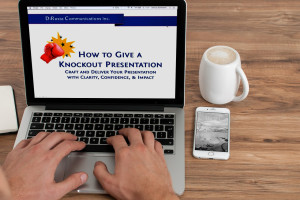 Could a top presenter bomb in the virtual world?
Your keynotes get rave reviews. Your training seminars are highly rated. Your reputation as a public speaker precedes you. So giving a webinar should be a snap. Or not. The mistake many otherwise excellent speakers make is to approach webinars the same way they deliver an in-person speech. Virtual communication offers new and different challenges. Here are some tips when transitioning presentations to the web.
Could a top presenter bomb in the virtual world?
Your keynotes get rave reviews. Your training seminars are highly rated. Your reputation as a public speaker precedes you. So giving a webinar should be a snap. Or not. The mistake many otherwise excellent speakers make is to approach webinars the same way they deliver an in-person speech. Virtual communication offers new and different challenges. Here are some tips when transitioning presentations to the web.
More Slides Not Less. Unlike the PowerPoint principle of fewer slides, in a webinar, the speaker must keep the momentum going. It's boring to listen to audio while one slide remains on the screen. To keep attention, scroll through multiple slides so that the audience is experiencing change more frequently. I once watched an online promotional video. Every time I reached for the mouse to fast forward, the video image would change. It was uncanny how this video changed images every time I was ready to tune out. I checked the timing. The change happened every 4 seconds. You don't have to be that quick but don't speak for 2 minutes on a slide.
Create a Relationship. Project a photo of participants on the webinar screen so that they can see themselves and others.This will allow you to speak to "real people," and the audience will feel more of a sense of community.
Warm Up. Don't dive in without a welcome. Introduce yourself and let people know why they are there and what you will cover. But don't announce every caller unless it's a brief private meeting. Mute the phones so that there is no background noise. People can hear a smile so bring your best game face and let your warmth shine through. To increase energy, stand when you're presenting and use a lively and conversational voice. Nobody wants to listen to a dispassionate book report.
Visuals Not Text. Forego bullets in favor of graphics, cartoons, illustrations and interesting photos.The brain thinks in pictures, not in words. And if there is enough text for them to read the slides, they won't need you. Make sure the graphic files are not too large or they will take too long to download.
Interact. Don't be a talking head. If you don't want the audience to check email, create a two way communication. Make use of chat boxes and polling. Ask questions. And if possible, open the phone lines so that people can participate. Build interaction every 3-5 minutes. An effective webinar is not a deck of slides with a voice over.
Make Eye Contact. The best way to connect with a virtual audience is to use video. If they can see you talking, the audience will be more engaged. Programs like Adobe Connect provide video capacity so that the presenter can look directly at the audience. This will increase engagement and trust. Another alternative is to embed very quick, brief videos on the slide to demonstrate your point.
Design Peer-to-Peer Learning. Make use of break out rooms online. This allows you to assign learners to small groups to discuss concepts and create new ideas. Adults want to participate and control their learning. As the facilitator you can listen in on each group while they can only hear the members of their small group. When finished, you can bring back participants to share their learning.
Virtual doesn't have to be boring or detached. To deliver winning webinars, consider these seven tips when converting your presentation to the web.
Boring to Brilliant Public Speaking: Make Dry Topics Dynamic
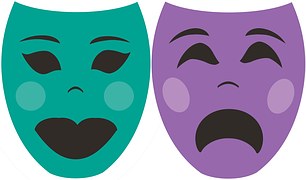 There are no boring topics-only boring speakers. Just about every audience and coaching client has heard me make that statement about public speaking.
Recently, a client proved my theory at a corporate conference. He and his team were charged with creating a panel presentation to introduce the new compliance directives and expectations. Are you falling asleep yet? If you were a public speaker would you be panicking about how to keep people's attention? Unless the topic of compliance is your passion, or you're a trained actor, you'd be wondering how on earth you could possibly make this subject dynamic and interesting. But they did! Here's how:
There are no boring topics-only boring speakers. Just about every audience and coaching client has heard me make that statement about public speaking.
Recently, a client proved my theory at a corporate conference. He and his team were charged with creating a panel presentation to introduce the new compliance directives and expectations. Are you falling asleep yet? If you were a public speaker would you be panicking about how to keep people's attention? Unless the topic of compliance is your passion, or you're a trained actor, you'd be wondering how on earth you could possibly make this subject dynamic and interesting. But they did! Here's how:
The presenters wrapped a Star Wars theme around compliance. The presentation began with a Star Wars- like graphic slide complete with music and scrolling text.They substituted compliance terms into the text about the challenges of the galaxy.
After the slide faded to dark, the presenters walked on stage. When the lights went up the audience saw the panelists standing with lasers. The moderator walked center stage and spoke his opening line directly to the audience. But wait. There was more.
As the panelists were seated, the moderator looked around in surprise One of the panelists was missing. After much curiosity, the last panelist entered as Princess Leia dressed in white. She appeared as an imaginary hologram portending the future and then left the stage. She returned as herself and took her seat. By this time the audience was laughing, engaged, and revved up.
The panel discussion continued smoothly as the audience was truly primed to listen. Midway during the panel, to avoid any monotony, the panel called R2D2, complete with sound effects in one of the slides. The moderator then announced a Question and Answer session.
And.just when you thought it was safe to be boring, the first questioner turned out to be Darth Vader in costume. He caused a commotion with his comments and his laser and was quickly escorted out by "security". The panel ended on a high note I'm sure it will be talked about for some time to come.
So what can we learn from this creative approach to a dry topic?
Wrap a dry topic in a dynamic, familiar theme. Movie and book titles are good sources for ideas.
Use music and sound effects to create excitement and emotion. This is especially potent when the audience recognizes a theme song. It can be as brief as a chorus or refrain.
Create visual interest. Props, graphics, and costumes are an alternative to slides. A prop can be a dollar bill or it can be people from the audience. The idea is to stimulate all the senses.
Trigger the element of surprise. The audience was not expecting Princess Leia and Darth Vader to appear in the audience. A simple magic trick or quick poll can be the source of the unexpected or unknown.
Leverage technology. Presenters don't have to rely exclusively on PowerPoint. Videotape an interview or talk to a remote site using live streaming.
Have fun. What made a boring topic exciting is that the presenters were having fun. Nothing engages an audience like laughter. When you're having fun, you abandon fear and become fully present in the moment and with the audience.
And that means never being boring again.
10 Steps to Confidence
Why do we spend years on developing competence when research proves that CONFIDENCE trumps COMPETENCE? Because we falsely believe that it's our smarts and not our hearts that get us to the top. So how do you learn confidence? Here are 10 steps to confidence.
- Clear. Get clear about who you are as a person and get clear about your presentation outcome. Clarity is the first step to confidence. Focus on your message and establish a benchmark for achieving your presentation outcome.
- Other-Centered. Nervousness is self-centeredness. Turn your attention away from you and toward your audience. Ask, "How can I serve them?" "How can I make them comfortable." Do a deep dive into the minds of your listeners. When you profile your audience, you'll speak their language, create rapport, and you'll feel more prepared.
- Natural. There is only one you. You have your own unique style. Don't set out to give a presentation. Be conversational and be yourself. If you're not funny, don't tell a joke. Share something personal and the audience will relate to you.
- Free from Judgment. Eliminate your need for perfection and stop" shoulding" on yourself. Monitor your self-talk. When you begin the presentation, imagine success. When you finish the presentation, give yourself credit for the things you did well. Confidence develops over time and in a positive atmosphere. Mohammed Ali said "I am the greatest," before he was ever a champion
- Improvise. Public speakers who are wedded to their scripts can be easily caught off guard if they lose their place or if there is a technical glitch. Learning to improvise will boost your confidence. When disaster strikes embrace it instead of freezing in place. Prepare your recovery strategy with ad-lib lines.
- Design. Confident delivery sits on well-designed structure. Confidence begins before you ever open your mouth. It starts with good organization. Good structure will keep you focused and on message, And your audience will be able to follow your points.
- Enthusiastic Enthusiasm sells. When you're excited, you forget your nervousness. Speak from your passion and you'll find your energy increases. Raise your energy by doing something physical. Move around the room. Get louder. Use more gestures.Enthusiasm is contagious and your audience will be excited along with you.
- Network. Do you feel like the naked speaker up there all alone? To gain confidence network before you speak. Get to the room early and practice. As people enter, greet each person with a smile and a handshake. By the time it's your turn to speak you'll be in the company of friends.
- Concise. A speech can quickly unravel if the speaker gets stuck in the weeds of details. To feel confident, get to the point. Create crisp message points and build examples around each point. Instead of rolling their eyes, the audience will hang on your every word.
- Engaging. It's hard to feel confident when you're a talking head. Give fewer facts and tell more stories. Why are stories so powerful? Stories draw the audience in, break down resistance and entice them open to your message. Stories make your message memorable. And here's the bonus point.. A story has a natural sequence so you don't have to worry about losing your train of thought. Simply tell the story. Be in the story and your audience will be engaged.
Re-Launch of “Give Fear the Finger”
FOR IMMEDIATE RELEASE March 2016
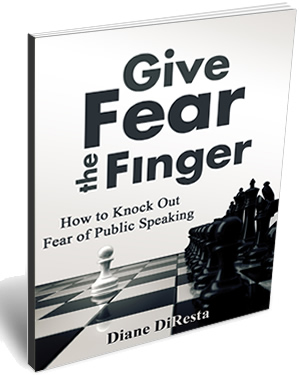 DiResta Communications Recognizes International Women’s Day with Re-Launch of “Give Fear the Finger”
DiResta Communications Recognizes International Women’s Day with Re-Launch of “Give Fear the Finger”
Diane DiResta, author, speaker and owner of DiResta Communications honors the 2016 theme for International Women’s Day—Gender Equality
New York City, NY: “International Women’s Day is a time to reflect on progress made, to call for change and to celebrate acts of courage and determination by ordinary women who have played an extraordinary role in the history of their countries and communities.” The 2016 theme is “Planet 50-50 by 2030: Step It Up for Gender Equality.”
Diane DiResta, in keeping with this theme, is relaunching her latest book, Give Fear the Finger: How to Knock out Fear of Public Speaking and making it available for only $.99 for the rest of the month, starting with International Women’s Day.
Give Fear the Finger shows women (and men) how to never be nervous again. Diane teaches the reader the secrets to being confident and fearless whether speaking to one or 1000. The interactive ebook shows how to stand up to fear and command the platform. Gifted speakers are born but effective speakers are made. Speaking is the new competitive advantage and levels the playing field for women. It gives them visibility they might not access and allows them to have a platform. Speaking let women celebrate their social, economic, cultural and political achievement.
Diane DiResta, who grew up on military bases around the world, began her career as a speech pathologist and now travels internationally teaching interpersonal communications and presentation skills. She traveled to Russia to speak to women entrepreneurs and teaches public speaking in countries like Tanzania, Africa; Bermuda, Brazil, Egypt, Spain and the UK. Diane’s mission is “empowering through the spoken word.”
About Diane DiResta, CSP
Diane DiResta is the founder and CEO of DiResta Communications, Inc, a New York City-based communications skills consultancy serving business leaders who want to communicate with greater impact – whether one-to-one, in front of a crowd, or from an electronic platform. DiResta is a certified speaking professional, a designation held by 12% or professional speakers nationwide. She's also the author of the ebook Give Fear the Finger: How to Knock Out Fear of Public
Speaking and Knockout Presentations, an Amazon.com best seller and widely used text in College business communication courses, entrepreneurship, and more. Celebrated for her inspirational message and inviting presentation style, Diane draws from her knowledge and expertise to engage and motivate her audiences to become the change agents in their own lives and businesses.
For additional information on Diane visit her website - http://diresta.com
To order a copy of Give Fear the Finger for $.99 (beginning Tuesday, March 8) - http://amzn.to/1Y3Bo6k
To schedule an in interview with Diane, contact her publicist, Sandy Lawrence
sandy@perceptivepublicrelations.com
281-989-8892 (Cell)
Is Amy Cuddy's Wonder Woman Pose A Fraud?
 My colleague TJ Walker challenged the validity of Harvard professor, Amy Cuddy's power pose. Amy Cuddy has one of the most popular youtube videos on body language. She advises people to adopt the Wonder Woman pose (hands on hips) to feel powerful when speaking in public. In TJ's twitter post today, he disputes this claim and calls it a fraud.
Here's my opinion. The power pose was recommended to assuage public speaking fear. It's based on neuroscience research and when this pose is held for 2 minutes, there is an increase in testosterone. Higher levels of the hormone, testosterone, are found in those who are risk takers.
My colleague TJ Walker challenged the validity of Harvard professor, Amy Cuddy's power pose. Amy Cuddy has one of the most popular youtube videos on body language. She advises people to adopt the Wonder Woman pose (hands on hips) to feel powerful when speaking in public. In TJ's twitter post today, he disputes this claim and calls it a fraud.
Here's my opinion. The power pose was recommended to assuage public speaking fear. It's based on neuroscience research and when this pose is held for 2 minutes, there is an increase in testosterone. Higher levels of the hormone, testosterone, are found in those who are risk takers.
What was novel was that there was Harvard research backing up her claims. Do I think she's a fraud? No. Unless the research is flawed, it's helpful to have a technique to increase confidence. And there is a body language of confidence. The mind-body connection is widely accepted.
However, as an executive speech coach who works with women leaders and male executives, I don't claim that this one pose is a panacea for public speaking fear, nor does it make you a knockout presenter. TJ makes several good points. Amy Cuddy had a compelling story, a strong structure to her speech, and good visuals. I always tell my clients that great delivery sits on great structure. Your presentation delivery is only as good as your organization. Public speaking success is 90% preparation and 10% delivery.
A client recently hired me for four hours to work on a 15 minute high stakes presentation. That did not include the time she spent with the graphic designer.
So to feel confident, the first step is preparation, planning, and a good, strong message. Presenters need to master their minds as well as their skill set. Does it help to use the power pose? Probably. I teach it to audiences. It makes them feel powerful. But it's not the whole story. There are other physical skills I give them. But I do believe that the mind affects the body and the body affects the mind.
So as long as presenters prepare and practice their message, why not strike a pose and feel powerful?
https://www.youtube.com/watch?v=Ks-_Mh1QhMc
Stay on Message Without Being Scripted
 In a Republican debate, Senator Marco Rubio had emerged as a great orator and touted his third place standing as a win. There was a lot of buzz about Rubio and he was riding high despite being number three. So it was no surprise that he walked into the next debate confident and expecting more of the same.
And then it happened. Governor Chris Christie hammered him. Christie came down hard on Rubio for reciting his message point for a third time and accused him of being scripted. It didn't go well for Rubio and Christie won that round.
In a Republican debate, Senator Marco Rubio had emerged as a great orator and touted his third place standing as a win. There was a lot of buzz about Rubio and he was riding high despite being number three. So it was no surprise that he walked into the next debate confident and expecting more of the same.
And then it happened. Governor Chris Christie hammered him. Christie came down hard on Rubio for reciting his message point for a third time and accused him of being scripted. It didn't go well for Rubio and Christie won that round.
How can the skill of staying focused and on message be to the detriment of a public speaker? As a speaking strategist and media trainer, I advise my clients to know their message and to stay on message. This is especially important in a media interview. A skilled media guest will lead with key messages and weave them throughout the interview.
The red flag is when the presenter doesn't answer the question and defaults to a message that doesn't follow the line of questioning. What should Rubio have done? Answer the question to the best of his ability without repeating the same message point again.
Most of us won't be running for office or even presenting in a formal debate. But we will need to persuade, convince, and inform our stakeholders. I advise audiences and clients to familiarize, don't memorize. When a public speaker repeats the same points too close together and uses the exact same words, that's when authenticity is lost. That sounds scripted.
The first mistake is reading a manuscript word-for-word. It takes a special skill and much practice to deliver the words so it doesn't sound like you're reading text. Some scientific lecturers stand and read their research. I told them, "I can read as well as you." Why would anybody want to listen to the reading of a research paper?
The second mistake is memorizing word-for-word. Even though the presenter is not reading, it's obvious the message is not natural.
When I first started out in the speaking business, I worked for a seminar company. At the end of every seminar my manager and I would read the reviews. To my surprise, someone wrote, "Diane, though, helpful, sounded canned." Yikes! Put a stake in my heart. But I realized that I had memorized the script they gave me and I sounded like a talking head. With practice, I learned how to sound conversational and make the content natural.
Audiences are more sophisticated than ever. They want to hear a subject matter expert and not a presenter giving a book report. They want to know you're authentic. You achieve that by preparing your message, practicing your message, and listening for when to divert from the message. It's in listening that we become truly authentic.
And the Best Speaker Is....
 Speaking is a leadership skill. Period. It's difficult to lead if you can't convey a clear, compelling message that inspires and moves people to action.
Last night the candidates eagerly awaited the results of the Iowa Caucus. It was a tight race with Hillary Clinton and Bernie Sanders almost tied. But the real winner was the orator of the night-Marco Rubio.
Speaking is a leadership skill. Period. It's difficult to lead if you can't convey a clear, compelling message that inspires and moves people to action.
Last night the candidates eagerly awaited the results of the Iowa Caucus. It was a tight race with Hillary Clinton and Bernie Sanders almost tied. But the real winner was the orator of the night-Marco Rubio.
While Ted Cruz came in first, his victory speech was too long, too analytical, and not inspiring. I kept changing the station in search of commentator's reviews. Each time I toggled back, there was Ted, still droning on. This was a lost opportunity to inspire and build excitement for the next race. I didn't remember much of his speech.
Donald Trump came in a close second. The usually pompous, bombastic Trump took it down a notch and gave a gracious concession speech. He thanked and acknowledged the people of Iowa and congratulated Ted Cruz. This was a different Donald Trump and he won points in building trust with his followers. He kept his remarks brief and didn't make excuses. This was a model for losing gracefully and yet not giving up. In keeping with his entrepreneurial personality, he cut his losses quickly and moved on to the next phase.
The real stand-out was Marco Rubio who was neck-in-neck with Mr. Trump. While his speech was well-prepared, his words and delivery were passionate and heartfelt. He stayed on message with his immigrant story, his family values, and the need to conquer the competing party. We could relate to his classic hero's journey. " This is the moment they said would never happen. For months they told us we had no chance. They said I had to wait my turn". . Although his speech was criticized for sounding much like Obama's speech back in 2012, he left his constituents inspired, exhilarated, and confident in his leadership. Rubio turned a third place result into a victory speech.
On the Democratic side, Hillary Clinton was at her best. Her fire was not only in her belly but on display in her eyes. She also gave a victory speech even though the results were too close to call. Mrs. Clinton connected with her audience and carried her enthusiasm with her as she exited the stage.
Bernie Sanders, although older than Clinton, communicates energy. He, too, was impassioned in his delivery. The young people not only fed off his message of free college and taxing Wall Street, but his energy and strong conviction connected with this audience. He regarded the evening as a tie with Clinton and expressed confidence in winning New Hampshire. Energy sells.
Will the best speaker win? Not necessarily.There's more to winning a political race than public speaking. But excellent presentation skills will elevate a candidate's leadership, enhance the brand, inspire trust and confidence. Words well written and delivered with absolute conviction and passion will always linger in the hearts and minds of the listeners.





